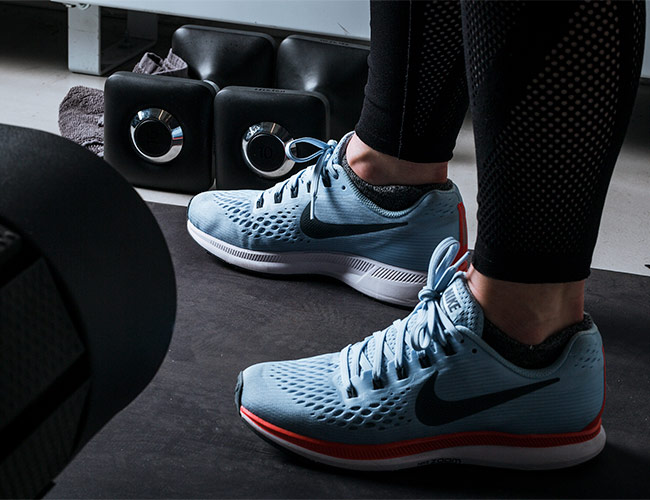Peloton, a brand that’s earned a cult-like following around the world, thanks to its stationary bikes for your home gym, is releasing a high-tech treadmill. It doesn’t ship until this fall, but we were granted early access to give it a test run.
The Good: Everything you love about the Peloton bike is now also available on the Tread. Streaming live classes (up to 10 a day) are visible on a 32″ HD touchscreen, and with strength workouts incorporated into each workout, you can follow along both on and off the Tread. Think Beyond the Ride classes, but now off the treadmill.
The machine itself is made up of 59 individual slats designed to be cushiony and smooth. The slats are similar to a Woodway (which is at the more luxurious side of the treadmill spectrum) as opposed to running on one belt. And the ride does feel good — at no point during or after did I feel pain in my feet or knees. The side panel is covered in a grey fabric that matches the sound bar on the screen. “Early on, we decided we wanted to do a lot better to incorporate it into the home and not just put plastic and metal everywhere,” Maureen Coiro, Senior Product Manager of Hardware for Peloton, says. It has a zipper, so you can store your floor mat, resistance bands, and smaller weights.
Once you hop on and are ready to run, there are two knobs on the handrails — one on each side. On your right is the speed dial and on your left is the incline. Both are very sensitive and seem intuitive. Why haven’t treadmill creators done this before? There’s no hard pressing a button to get your speed up to the number you want. And if you want to stop, you just spin the dial toward you, or press the one actual button on the machine.
The screen holds all the streaming and on-demand workouts from trainers Robin Arzon and Rebecca Kennedy. Scroll through the classes, pick the one you want and then off you go. Since you are working both on and off the Tread, the machine will tell you what extras you need like weights, mat, etc. It’s best to have them close by since you don’t want to run to the other side of the room to collect your weights during the short rest time. The workouts I’ve tested were each about 20 minutes long, taught by Kennedy or Oliver Lee, and was broken down into 10 minutes on the Tread and 10 minutes off.
So, was it hard? The more time I spend on the treadmill, the more comfortable I get with it and the faster I run. While I might not be sweating immediately, I’m certainly sweating by the time I hop off the treadmill to launch into the second half of the workout. The constant back of forth from the treadmill to floor forces your body to work hard and gives you a surprising burst of energy each time you complete a session and jump into the next. I can’t wait to test out some of the longer classes and the ones that are 100% on the treadmill.
Some fun extras I appreciated: There’s a proper warm up and cool down, which you often don’t get in class, and a pop-up with the names of each song. You can see the playlist beforehand, so if there’s a song you hate, you can just skip to the next workout with tunes you enjoy. There’s also a manual mode, which is great to include for off-the-treadmill work: Think sled pushes.

Who They’re For: Both newbie runners and advanced runners will appreciate the treadmill and its class options. The trainers provide a barometer for how you should feel (Kennedy gave me a 1 to 10 rating after each sprint) and then also provide a range of speeds for walking, jogging and sprinting.
If you love the Peloton bike, you’ll likely love the treadmill. And if you love running, but hate the treadmill, this is also enticing. The leaderboard draws you in, the video connection is great, and the constant addition of classes means you’ll never be bored.
Watch Out For: You’ll have to get used to listening to the trainer as you move from the treadmill to the mat. I couldn’t always see the screen (mostly due to glare), but you are able to move the face of the screen up or down to help with visibility. My mat was right next to the treadmill, whereas at home, I’d situate my mat behind the treadmill so I’m looking directly at the screen.
Treadmills range in price from $900 to up over $7000, so $3995 is on the slightly higher end of the spectrum. If you’re someone who can hop on the treadmill and run five miles on your own, you can save a lot of money if you don’t need a trainer or coach to motivate you and provide you with workouts, which is really one of the major draws of this machine. You have to pay a subscription to get unlimited classes (currently bike subscribers pay $39 a month). Since classes in NYC range from $20 to $40, this subscription will quickly pay for itself, especially considering there are both on treadmill and off treadmill classes.
The mat and weights that I used at the lab do not come with the treadmill. If you already have a home gym, you likely already have some weights and a yoga mat, but if not, it’s an additional expense. And then you’ll need enough space for the Tread and accessories.
Alternatives:
There really isn’t anything else out there like this in the market. There are certainly cheaper treadmills, but not many come with the opportunity for unlimited classes. The closest you can get to emulating the experience is if you already own a treadmill (or head to the gym) and then use an app like Aaptiv or Studio to listen to a workout on the treadmill.
What Others Are Saying:
• “When developing the Tread, one of the things Coiro and the rest of the design team loathed about competitor units were the buttons. After all, there’s nothing worse than jumping on a treadmill and being forced to hit the “up” button a million times to get to the speed you want. It’s also difficult to accurately hit buttons if you’re sprinting along at full tilt. To solve this problem, the Tread features a knob on each side of the handrails, one for speed and one for incline. You can crank the Tread to a max speed of 12 miles an hour and up to 15 degrees of incline. The knobs are big and chunky, easy to grab on the fly. (There’s still a button in the center of each dial, the press of which adds one unit to your speed or incline.).” — Sean Evans, Men’s Health
• “Peloton has made home fitness more convenient and high-tech than ever. The Tread is no exception – it’s easy and fun to use, and I stayed motivated throughout the workout. But space is an issue. While The Tread isn’t going to make the squeeze into a boxy New York apartment, it’s a good solution for anyone who doesn’t have a boutique fitness class at their doorstep.” — Mary Hanbury, Business Insider
Key Specs
Footprint: 6′ x 2.7′
Dimensions: 72.5″ L x 32.5″ W x 72″ H
Slat Belt: 67″ L x 20″ W
Screen: 32″ diagonal
Exercise mat: 2′ x 4′
Speed: 0-12.5 mph
Incline: 0-15% grade
The Epic React running shoe performs well in practically all conditions, but are they the right shoe for you? Read the Story





